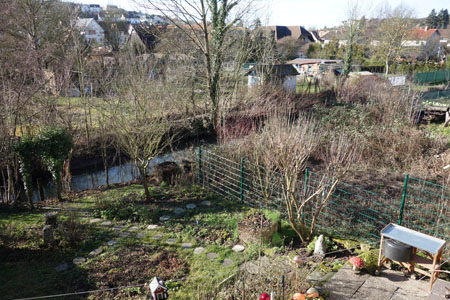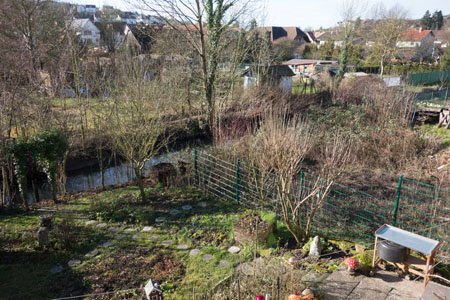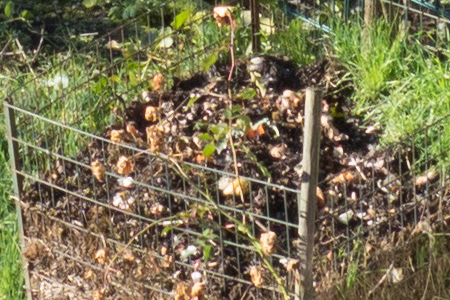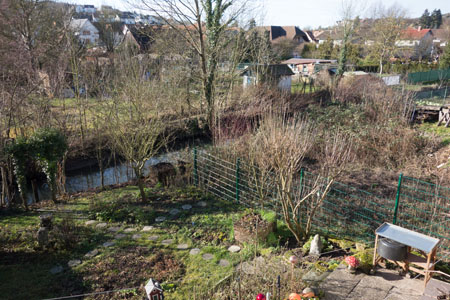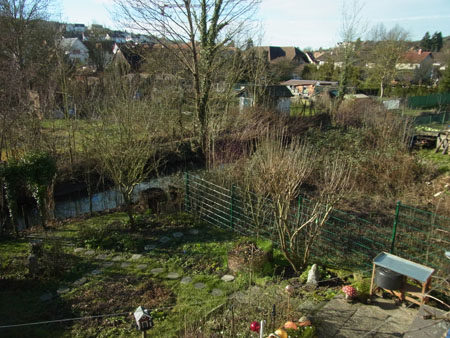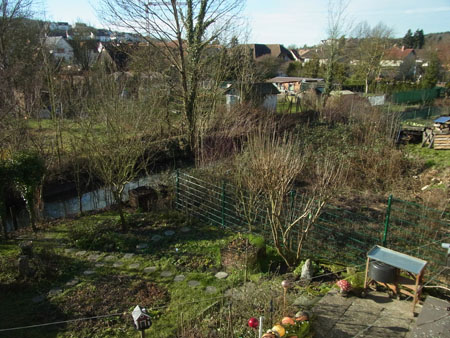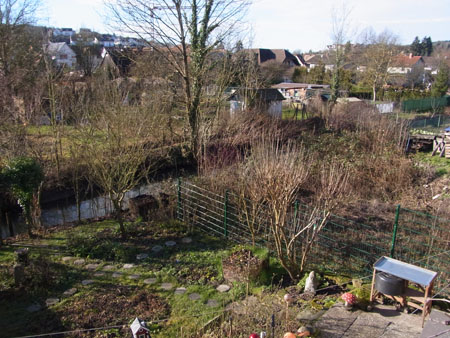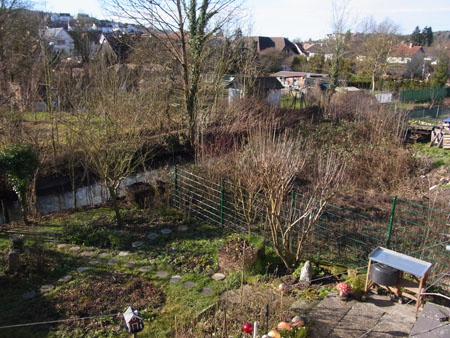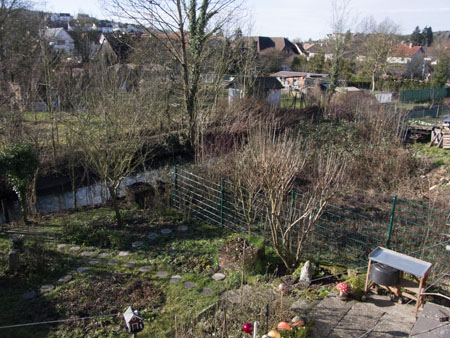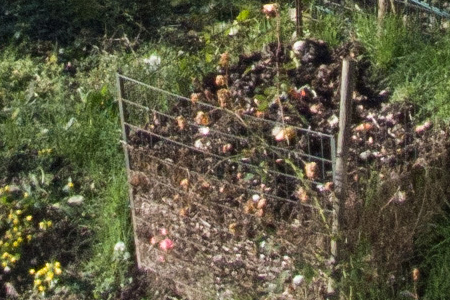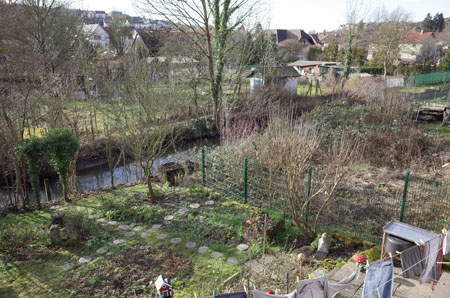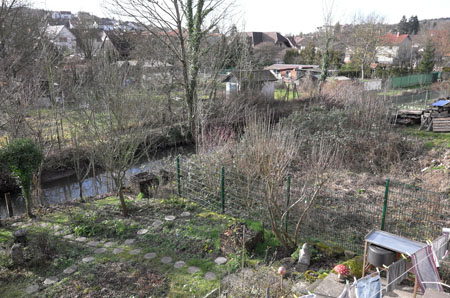Sony RX100 M1: Quick-and-Dirty Photo Comparison with other Cameras
On this page, I present a quick-and-dirty comparison of photos of a garden scene that I took with several cameras. You can download and print the original files to make up your own mind about, which camera or better, camera type - compact 1/2.3" sensor, 1" sensor, APS-C sensor - would suit your personal needs for viewing the photos on your computer screen or for printing them at sizes that you need (postcard, DIN A4, or larger).
Read the introduction for my motivation for this page.
Introduction
As written elsewhere, a Russian RX100 M1 user asked me for practical help on the Merklinger method. In the long run, his "main question" was, however, "If I very rare print (and not more than 9 x 12 cm) and view the images mainly on the computer screen - is that method necessary for me - or is it enough to use the standard DOF approach?" He used this approach for many years and was quite satisfied with it). This question initiated another, related question for me, which is the one that I want to deal with on this page, "Given the two main usage styles for my photos, is it necessary to own a camera like the Sony RX 100 M1 (or even better), or would a small sensor camera suffice?"
I would like to remind you that we bought the Sony RX100 M1 just because we were not content with the results of my wife's Ricoh CX4, which has an 1/2.3" sensor. Particularly, when we viewed the images on the computer screen (admittedly, an Apple Retina display), the CX4 images looked disappointing in comparison with my photos that were taken with APS-C sensor cameras (Leica X Vario, Ricoh GR and GXR). Since I rarely printed photos that were taken with the CX4, I can comment little on this. But as far as I remember, a Christmas card (this a postcard) was fuzzier that I would have liked...
It is not my intention to give any recommendations here. Everybody has his or her own "quality standards". But if you ask yourself a similar question, you can at least, download the original photos, view them on your computer screen, print them at the sizes you need, and make up your own mind on this. In the Conclusions below, I tell you how I think about this. But please keep in mind that this is just my personal opinion, not more, not less...
Sample Photos
I took the photos with the following cameras under the following conditions:
- 1/2.3" sensor:
- Ricoh CX4 (10 MP) "normal" and with "in-camera" sharpening (strong = second strongest setting)
- Ricoh GXR with P10 camera unit (10 MP); this is essentially, very similar to the CX4, but obviously with better lens quality, and it offers RAW format (DNG). I included RAW in the comparisons, because I had found out in the past that processed DNG images were more detailed than JPG images, but also grainier. The DNG photos were converted with ACR (Adobe Camera RAW plug-in) for Photoshop Elements (no settings changed).
- 1" sensor:
- Sony RX100 M1 with native 20 MP and with 10 MP, JPG and RAW (ARW). Most JPGs were created by the camera in JPG+RAW format. The ARW photos were converted with ACR (Adobe Camera RAW plug-in) for Photoshop Elements (no settings changed).
- APS-C sensor:
- Ricoh GR (16 MP), JPG only
- Leica X Vario (16 MP), JPG only
*) ARW is the native Sony RAW format; DNG is an open RAW format, developed
by Adobe and used by Ricoh (and Leica).
**) ACR = Adobe Camera Raw; plug-in for Adobe Photoshop (Elements) and Adobe
LightRoom for the conversion of RAW images
Conclusions
Computer Screen
As mentioned above, we bought the Sony RX100 M1 because we were not satisfied with how the Ricoh CX4 photos looked on my computer screen, which is, however, a 15" Retina display (2.880 x 1.800 pixels, 220 dpi). But from a little bit farther away, a normal 15" screen (about 100 dpi) should look more or less the same.
When I look at the photos from this test on my computer screen, my personal conclusion is:
- The photos taken with the Ricoh CX4 and the Ricoh GXR P10 are not
really "acceptable" for me. While sharpening helps a little, and the GXR
P10 photos are slightly better, the images are overall not as clear as those
from the other three cameras.
Moreover, both cameras show signs of decentered lenses, namely fuzzy edges or corners (CX4: right edge; GXR P10: upper left corner). - The photos taken with the Sony RX100 M1 have a quality that is comparable
with the photos taken by the APS-C cameras. Perhaps, some corners are a little
bit soft (as was found in tests)...
The for me surprising result is that, when viewed on my computer screen, there is no recognizable difference between the native 20 MP and the 10 MP resolution. But this not should come as a surprise, because the screen has much less than 10 MP (about 5 MP). Later, I found that you could even use the camera's "native" 5 MP formatas well (I can go down to about 3 MP without serious quality changes on my Retina display, see below). - The sharpest photos are delivered by the Ricoh GR, probably because it has a very good lens and no AA filter.
All in all, I learned two things from this comparison:
- A pixel is not a pixel - its size is also important. Both small sensor cameras have 10 MP, but even on a 5 MP computer screen their photos do not satisfied my quality requirements. A Sony pixel (or are there 4 pixels used?) delivers a much higher quality.
- Based on the criteria (1) postcard (or even DIN A4 print), (2) satisfying
look on a computer screen, the Sony RX100 M1 could be used with 10 MP resolution
without satisfying image quality. This would turn its 3 x zoom into a 6 x
zoom with a longest focal length of 200 mm (equiv.). Sounds good???
(Later, I found that using the camera's 5 MP resolution would still be acceptable - see below).
I assume, despite of this, we will still use the Sony RX100 M1 with 20 MP. In the end you can crop to 10 MP to get the impression of a 140 mm lens (5.1 x), ot to 5 MP for a 200 mm lens (7.2 x)...
Note: See below for more on the quality of downscaled photos (or photos with less Megapixels).
Printing in General and Postcard Prints
All cameras deliver 600 dpi or more when printing the photos above on a 6" x 4" postcard (15 cm x 10 cm), and 300 dpi or more when printing in DIN A4 size (about 20 x 30 cm). Thus, from a Megapixel point of view, all cameras would fulfill the "print criterion". But as I mentioned above, the look on the screen suggested to me that the Ricoh CX4 prints, and possibly the GXR P10 prints as well, might look somewhat fuzzier than those from the other cameras tested here. Since you never really know, until you verify it, I printed the most important version of the photos in postcard size (6" x 4", or 15 cm x 10 cm) and compared the prints. The 4:3 images were printed so that the left and right edges were cropped (where most of the image problems reside...) so that they covered the postcard completely.
When I look at the printed photos, and begin the comparison with the Ricoh CX4 photos, these seem quite OK at a first look and provided that I do not look too carefully. Overall, they appear a bit "muddy", though (the sharpened version is a tiny bit better). When I then progress to the Ricoh GXR P10, the Sony RX100 M1, and finally the Ricoh GR and the Leica X Vario, I find more details in the photos. They seem to look "crisper" and more detailed overall than the preceding ones. The printed photos of the APS-C cameras look very similar in detail, albeit on the computer screen, the Ricoh GR photo does show more details. By the way, there is no discernible difference between the prints of 20 MP and 10 MP photos from the Sony RX 100 M1 (as I had presumed...).
In the end, postcard prints are not my "final measure" for print quality, but for many photographers this may be the case...
Oh, I Nearly Forgot to Answer the Question...
I introduced this page with two questions, one posed by a Russian Sony RX100 M1 user, and one added by me:
- His question will not be answered here but summarizes the usage scenario for the photos taken with the camera: If I very rarely print (and not more than 9 x 12 cm) and view the images mainly on the computer screen ...
- My question goes into the direction "small-sensor" vs. "larger sensor" camera: Given the two main usage styles for my photos, is it necessary to own a camera like the Sony RX 100 M1 (or even better), or would a small sensor camera suffice?
Preparing this page taught me that I can take another factor into account under these circumstances, namely the number of Megapixels that a photo has.
The simple answer is: For the above-mentioned viewing and printing requirements, an image size of 5 MP suffices (see also the Afterword). Print quality may be somewhat marginal, if you want to print your photos in DIN A4 size (or 10" x 8" size). A test will reveal whether you will find the print quality "acceptable" in this case. The main problem is that there are no cameras these days with a resolution of 5 MP. But some cameras, like the Sony RX100 M1, offer this as an image size option (in fact, there it is the minimum size...). So you can have it without much work.
But what about the sensor size? In my opinion, the tests show (once again) that sensors beginning from 1" size are superior to small sensors, particularly in low light. The photos taken with our small-sensor cameras look "muddy" in comparison. I would never buy a small-sensor camera again (but you never know what the technical progress will bring us in the future...). All in all, 5 MP on a Sony RX100 M1 look like the "dream team" for the above requirements.
A Final Word: The Future...
A final word, before you exchange your DSLR or system camera for a small-sensor camera, because you think that you do not need the many pixels and the "excess" of image quality that it offers. The times, they are a changin', as Bob Dylan sings. I five years, you may own a 4k (about 8 MP), 5k, or even 8k monitor, and suddenly your images may no longer render well if they were taken with a small-sensor camera. They may still be OK if taken with a Sony RX100 M1 in 10 MP mode (because of the "better" pixels), but who knows what will be in 10 years time ore more...
At the moment, the photos that I took 10 years ago with my Minolta Dimage 7, 7i, and A1 have about the 5 MP resolution of my computer screen (there are differences in aspect ratio: 4:3 versus 16:10). Older photos have an even lower resolution (from 0.5 to 3 MP).
I searched my hard disk and had a quick look at some older photos taken with different cameras. Photos with 3 MP appear still OK for me on the Retina display (5 MP is better, of course), but photos with two or even 1 MP are no longer OK. You can, however, display these photos at a lower magnification, so that they appear sharper (and smaller).
Afterword
Since the comparison ended up with a comparison of various image sizes on a certain screen size (Retina display, 5 MP), I thought that it might be a good idea to scale a photo down to various "old fashioned" screen sizes and offer these downscaled versions for downloading, comparing on the screen and printing. From the photos shown above, I selected the Sony RX100 photo below on the left for this purpose. I also put a photo that the camera scaled down to 10 MP next to it for easier comparison (below on the right). The camera also delivers 5 MP images, but I forgot to create a photo with this resolution, when I took the photos above.
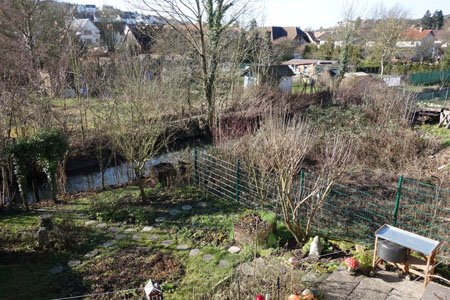 |
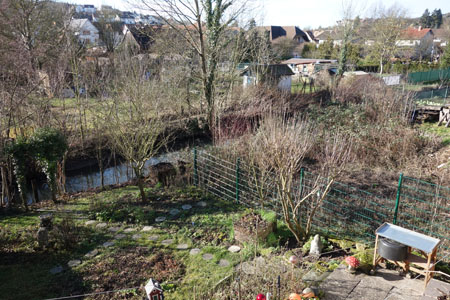 |
|
Sony RX100 M1 - 20 MP - JPG from "RAW & JPEG" |
Sony RX100 M1 - 10 MP - JPG from "RAW & JPEG" |
Click the photos above for the original 20 MP (left) and 10 MP (right) versions.
Here are downscaled versions of the photo on the left:
- 10 MP (3888 x 2592), 10 MP as from camera (648 dpi on a 6" x 4" postcard)
- 6 MP (3000 x 2000 pixels), 3:2 (500 dpi on a 6" x 4" postcard)
- 5 MP (2736 x 1824 pixels), 5 MP as from camera, 3:2 (456 dpi on a 6" x 4" postcard; 232 dpi for 30 cm x 20 cm*)
- 3 MP (2154 x 1436 pixels), estimated 3 MP, 3:2 (359 dpi on a 6" x 4" postcard)
- 2 MP (1740 x 1160 pixels), estimated 2 MP, 3:2 (290 dpi on a 6" x 4" postcard)
- 1 MP (1245 x 830 pixels), estimated 1 MP, 3:2 (207,5 dpi* on a 6" x 4" postcard)
You can view the photos on your various computer screens and also print them. The original 20 MP file has an extreme high print resolution of 912 dpi on a 6" x 4" postcard.
I also downscaled the photo to achieve certain "standard" print resolutions on a 6" x 4" postcard:
- 200 dpi*: 1200 x 800 pixels (1500 x 1000 pixels would give 250 dpi)
- 300 dpi: 1800 x 1200 pixels
- 400 dpi: 2400 x 1600 pixels
- 500 dpi: 3000 x 2000 pixels
- 600 dpi: 3600 x 2400 pixels
*) Adobe Photoshop Elements issues a warning whenever I want to print a photo with a resolution below 220 dpi - probably oriented at 216 dpi, which is three times the resolution of the "original" resolution of 72 dpi (about a typographic point).
*) Note that a 5 MP photo achieves just the "bare minimum" print resolution of about 230 dpi when printed in 30 cm x 20 cm format. My printer allows a maximum of 28 cm, which results in a print resolution of nearly 250 dpi. This may or may not be acceptable for you (it was for me about 10 years ago when I owned a 5 MP camera, today I am not so sure about this)...
BTW: My Apple MacBook Pro's Retina display (2880 x 1800, 15") has a resolution of 220 dpi, just the minimum print resolution...
| 16.01.2016 |
